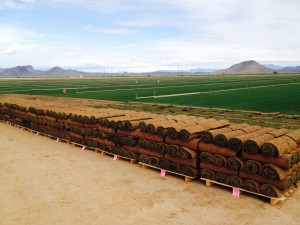Jan
Weeds and Your Arizona and California Lawns.
We haven’t had a very wet winter but with the recent rains we’re going to start to see the emergence of some winter annual weeds. The good news is the weeds that are starting to emerge are easy to control.
There are some types such as annual bluegrass, crabgrass, and nutsedge that are a little more complicated but timing pre-emergent herbicide applications can save you a lot of headaches with weed control. In this blog I will go over various weeds and some ways to control them as well as discuss herbicide timing. Weed control management is a function of several different factors but some of the things you can do to keep your lawn healthy are maintain the proper mowing height, not overwatering, fertilize monthly, and aerate the turf when the soil becomes compacted. These items right here can be the difference between weeds slowly emerging in your lawn and taking over your lawn. A healthy lawn will push out weeds and keep them to a minimum. If you have very few weeds emerge during the year chemical applications are usually unnecessary and weeds can be pulled by hand as they appear.
A pre-emergent herbicide is one of the most effective tools in lawn management. When it is properly timed it can save countless hours of maintenance and help prevent weeds from taking hold in your lawn. Before I start I think it’s important to explain the life cycle of a summer annual weed. The growing habit of a summer annual is emergence in the spring to early summer, grow and produce seed in the summer. In order to prevent them from coming up in the spring the right time to apply a pre-emergent is mid to late February to Arizona and California. This application should be made when the air temperature is consistently between 65-75 degrees.
As the temperatures begin to rise in March lots of the weeds will already be emerging from the soil so it’s best to make the pre-emergent application early. Pre-emergent herbicides control grassy weeds such as crabgrass, annual bluegrass, and some broadleaves. Most broadleaf weeds will need to be treated with a post emergent herbicide after they emerge. It’s best to wait until your lawn has greened up in April/May before applying a post emergent herbicide to a dormant lawn. It is okay to treat the weeds now as they appear in an overseeded lawn. Applying a post emergent herbicide too early can delay the spring green up of bermudagrass so I do advise spraying in April/May.
Pre-emergent herbicides come in several different categories but the main ones are prodiamine, benefin, benefin + trifluralin, dithiopyr, and isoxaben. The goal of these products is to put a weed control barrier between the grass and soil. The products listed can be found online, at hardware stores, and specialty stores that carry pesticides. Each store is going to have a different brand name for these products but the active ingredients should always contain one from above.
Since very few broadleaves are controlled with a pre-emergent herbicide it’s often necessary to make post emergent applications after the weeds break a tolerance threshold. Post emergent applications can be spot sprayed on the weeds keeping the amount of herbicide sprayed to a minimum. The most common types of post emergent herbicide applications are 2,4D, mecoprop, dicamba, and atrazone to control broadleaves.
Grassy weeds can be controlled with applications of 2,4D+dicamba+quinclorac, foramsulfuron, amicarbazone, sethoxydim, fluazifop, and fenoxaprop .These may require repeat applications in order to take care of the weeds. Nutsedge is not a grassy weed but is a sedge. Sedges are one of the most difficult weeds there is to manage. Chemical applications typically burn the leaf surface and can get it to disappear temporarily but it does grow back unless the entire plant is excavated. Some herbicides that are used to control nutsedge are betazon, imazaquin, and halsulfuron. None of these products will kill it 100% but they’re your best chance against this weed.
Everyone will have their own weed threshold but I advise you to make sure the use of herbicides is needed prior to making the application. Make sure you read and follow the label as herbicides can damage your lawn if overused.
Remember to turn your irrigation clocks off until your lawn starts to show signs of stress. Now is a great time to save water and let the grass thrive. As long as the temperatures stay on the warmer side granular fertilizer applications every 3-4 weeks will be sufficient. If we hit a cold period and begin to get hard freezes then the switch back to foliar fertilizers will be necessary until the weather changes.
If you have more questions just hot the “Ask Jay” button on the top of the page.
Until next time,
Jay


